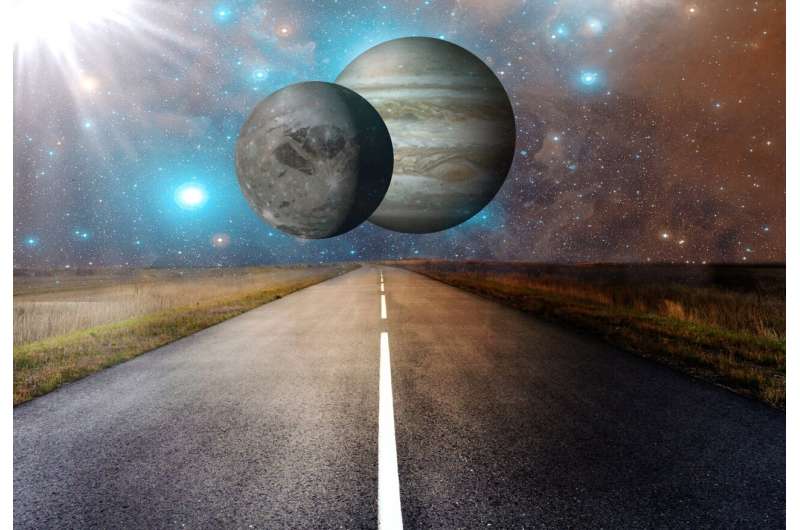This article has been reviewed according to Science X's editorial process and policies. Editors have highlighted the following attributes while ensuring the content's credibility:
fact-checked
peer-reviewed publication
trusted source
proofread
Astrophysicists publish Kepler Giant Planet Search, an aid to 'figure out where to find life'

A team of astrophysicists led by Lauren Weiss, assistant professor in the Department of Physics and Astronomy at the University of Notre Dame, created the first-ever catalog of small, Earth-like planets with Jupiter-like siblings (planets that share the same star)—a critical component in the search for life elsewhere in our universe.
Forthcoming in The Astrophysical Journal, the Kepler Giant Planet Search took a decade to complete.
"This catalog is the first of its kind and an unprecedented opportunity to explore the diversity of planetary systems that are out there with things that are like the solar system, but not exactly the solar system, and it gives us a chance to rewrite the story of how the planets form," Weiss said.
"The science question that I've been trying to answer over the past decade is: Of the other small planets like Earth that are out there, which of them have Jupiter siblings? Because this might be an important characteristic to look for, if we want to figure out where to find life."
Previous research over the past several years has singled out Jupiter as one of the reasons for life on Earth. During the formation of the solar system, Jupiter slingshotted rocky and icy debris and embryonic planets toward Earth's current location. Jupiter still hurls debris in Earth's direction today. The debris may have carried water to our planet intact, creating the oceans and later, fostering life.
Based on data collected from the W. M. Keck Observatory on Mauna Kea in Waimea, Hawaii, Weiss and collaborators recorded almost 3,000 radial velocities of 63 stars like our sun that host 157 known, small planets. The 157 small planets range from the size of Mars to the size of Neptune, and some of them have rocky surfaces that might be suitable for life. During the study, the team discovered 13 Jupiter-like planets, eight planets closer to the size of Neptune, and three companion stars.
Perhaps counterintuitively, large, gas-filled giant planets outside of our solar system are difficult to find because some common detection methods don't work. The Kepler space telescope, which retired after nine years in 2018 after it ran out of fuel, had been an excellent tool for scientists to find small exoplanets that orbited close to their stars. It used the transit method, which measures tiny dips in the brightness of the companion star to indicate the presence of a planet as it orbits its star.
Gas giants, however, are usually much farther from their stars and don't cross in front of them with any practical regularity for astronomers. Jupiter, for instance, takes 12 years to orbit the sun. Also, unlike planets close to their stars, distant planets often have slightly tilted orbits as seen from Earth, making the dips in brightness less prominent.
Weiss and collaborators used the radial velocity method, which uses Doppler spectroscopy. The team measured the "wobble" of a star as the waves appear to pull slightly closer and away from Earth based on the gravitational tug from a large, orbiting planet.
"Jupiters are large and they pull a lot on the stars we can measure. We can find them if we take many, many measurements over time, which is exactly what I had to do," Weiss said. For every star in the sample, she and collaborators observed the Doppler shift of the star's light waves for a minimum of 10 nights and in some cases up to hundreds of nights.
"It varies depending on the star," she said, adding that "observing" the stars wasn't done by directly looking through the telescope. Astronomers control the Keck telescope from remote observing stations worldwide, including at Notre Dame.
Though Weiss was excited about the discovery of the Jupiter-like planets, the catalog of Earth-and-Jupiter-like planetary systems is the aspect that will help astronomers in years to come. This paper, for instance, is the primary paper in the Kepler Giant Planet Search for which future papers will be based. Some will describe architectural patterns observed in planetary systems, the efficiency of detection of planets, and the joint occurrence of giant and small transiting planets.
"Probably the thing I'm most excited about is revisiting this story of how the Earth formed," Weiss said. "Now that we have more information about what other kinds of planetary systems are out there, we're looking for patterns, finding new discoveries, and these possibilities really excite me."
More information: The Astrophysical Journal (2023)
Journal information: Astrophysical Journal
Provided by University of Notre Dame





















